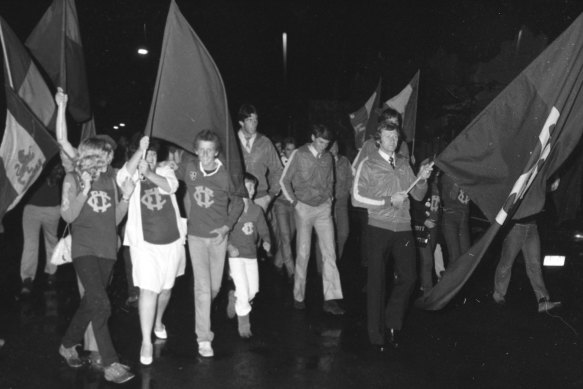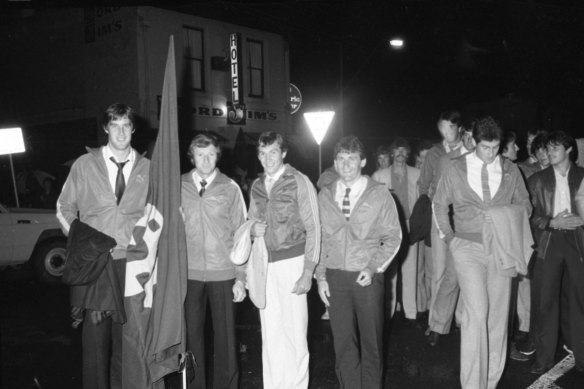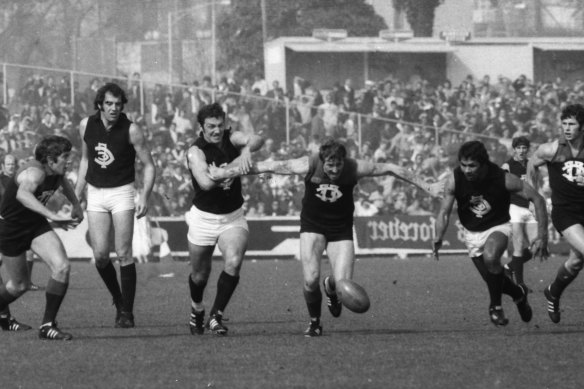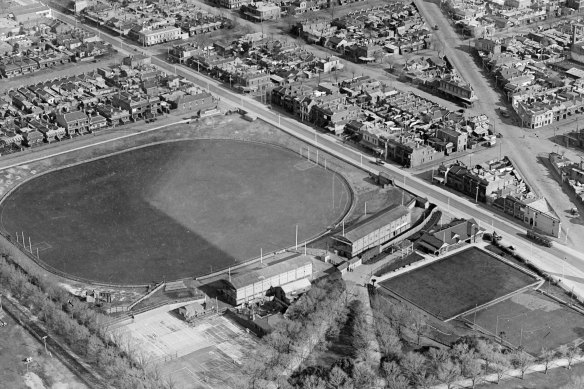From the Archives, 1983: Fitzroy Lions come home to celebrate 100 years
First published in The Age on March 22, 1983
Lions on parade
Fitzroy Football Club returned to its old home in Brunswick Street, Fitzroy, last night with a 30-piece brass band playing in the rain.
The Lions’ old warrior Kevin Murray led players and supporters on a march up Brunswick Street along the tramline to the ground.
Lions’ old warrior Kevin Murray carrying the club banner, led players up Brunswick Street along the tramline to the ground.Credit:The Age Archives
Fitzroy is 100 years old this year, so the club felt it appropriate that the presentation of 1983 guernseys should be made at the ground where the club began.
Players gathered with several hundred officials and supporters in a marquee in front of the old Fitzroy grandstand.
They had assembled half a kilometre away with the cheer squad, the Nunawading Brass Band and a police escort before beginning their march.
Out in front Murray, who played more than 300 League games, was the only ‘marcher’ who had played on the Brunswick ground which was vacated by Fitzroy in 1967 in the move first to Carlton and then to the Junction Oval, St Kilda.
Hopefully, Robert Walls has more discipline with his players on the field than he had with their marching formation last night.
First published in The Age on March 23, 1983
When a jumper turned men into Lions
Instruments glow wetly in the orange street lights. Maroon and blue uniforms blot the haze of rain. The Nunawading City Band stands outside a salubrious, restored watering hole in Fitzroy, Lord Jims. Footballers scurry past into the drier bar. The band bursts into a spirited rendition of the Marseillaise, the Maroons’ uplifting marching tune. A member of the soggy cheer squad says: “Geez, I’m getting embarrassed”, but sings all the same.
Outside Lord Jims pub in Fitzroy.Credit:The Age Archives
Lord Jims is only a couple of kicks from the Brunswick Hotel where the first meetings took place a hundred years ago which led to the formation of the Fitzroy Football Club. It is also only a chain of handpasses from the Brunswick Street oval, Fitzroy’s home ground for 73 of its hundred years. Everything is close to everything else in Fitzroy.
The story is that in the glory days of the club, brass bands would lead a procession of players and supporters from the Fitzroy Town Hall, doubtless having been addressed by the Mayor, all the way up Brunswick Street, cheered by throngs of locals and larrikins, to the home ground, where the players would be presented with their guernseys and numbers for the coming season.
Tonight’s destination is the old oval, but to a marquee full of $40 a head supporters, not a clubroom crammed with the same. The old grandstand is still there, or one of them. The fence is down, the ground belongs to the undeveloped, unrationalised, local past of the club and Melbourne’s smallest municipality. The romantics in the crowd wish that the coming procession was one to restore Fitzroy to its old home, but, of course, that has long been impossible. At least next season the Lions will be playing home games on the proper side of the river, nearby in Abbotsford.
The cheer squad done out in their elaborate colours, the band, the players inside having a refreshing squash or joking a bit uneasily about the blind eye turned to the usually illegal Monday night beer, the supporters in the street, and the waiting celebrants in the marquee were doing something that is unusual to say the least. They are holding a football ceremony, one all the more satisfying because it is taking place in private.
A few cars toot as they slosh past, a few puzzled diners stare as they look for the door to the pub, a photographer or two lurk, but to most of the world, the football world in particular, nothing’s happening. It’s just another Monday night.
Fitzroy captain Kevin Murray [C] breaks through after the ball between Carlton’s Syd Jackson [L] and Sergio Silvagni [R] at Junction Oval. The famous fog game at Junction Oval.Credit:The Age Archives
Inside the pub, a player says: “Well it is a high number, I know, but that doesn’t matter — does it ?” The property steward is throwing around the tracksuit tops to wear in the parade. There are only 23 tracksuit tops, not enough to go around.
There’s the great Kevin Murray, 333 games; 1969 Brownlow, pride of the Lions. He’s going to lead the march, but now he’s talking to the coach Robert Walls. All the players are on their best behaviour, it seems, but relaxed. Will Kevin Murray wear his No. 2 on jumper night?
If ever there was a player who exemplified the old-fashioned virtues of playing for the club, for the guernsey, Kevin Murray is it.
Remember when mortals grew another leg when they put on the jumper? Would play with a broken arm for the jumper? Would give up jobs and families to play for the jumper? Nowadays it’s supposed to be money that talks loudest. Players will switch from bidder to higher bidder. They are not supposed to put in, they’re “unhappy” if they’re not paid enough or someone gets paid more.
What is most surprising, if this is how footballers as a whole do behave, is the small number of changes and switches that are made each season. The vast sums expended on the handful obscure the majority who aren’t for sale. Perhaps it might be said that they aren’t good enough to invite an offer, but on the other hand some of those players who are bought are not thought of as being in the top 1 per cent either.
The jumper, despite the evident affection and loyalty most players have for the clubs they play for, doesn’t have its ancient mystical status anymore. It’s not the uniform to go to war in, the shield against the infidel. It’s not presented on purple velvet cushions, in a darkened room, to an awestruck player by representatives of Melbourne’s secret power groups, initiating the player into the rites of the club. But it’s still worn with pride.
Aerial view of Brunswick Street Oval looking south-east c. 1925-40.Credit:State Library of Victoria
The parade is about to leave. Kevin Murray’s not wearing No. 2, nor is it attached to a pole to be carried by a lesser player. Victorian football is a bit short on ceremony, so it’s hardly surprising that clubs have not adopted the American practice of retiring numbers. The tattered and bloodstained jumpers of the truly great — say Haydn Bunton, ‘Chicken’ Smallhorn, Dinny Ryan, ‘The Baron’ Ruthven and Kevin Murray — don’t hang from the ceiling of the clubrooms, and the lists of players don’t have a postscript with their numbers —never to be used by anyone else again.
Outside someone calls out to the damp players: “Form up! Tallest at the front! Fifteen rows of three!” The band plays, the banners fly and the bedraggled procession moves off.
There’s a police car, lights spinning, in the front and in the rear. Down Newry Street, music bouncing off the closed front doors of most of the houses. A few residents peek through the curtains, a pair stand on their verandah. Kevin Murray carries a flag, the cheer squad lets out a few quiet ‘carna Roys’.
Into Brunswick Street, bereft of traffic. A couple of old women come out and cheer. The cooks from the Chinese takeaway have a look and a wave. The Greek milk bar-deli stands mute.
Studio Marie is closed. The dry cleaners is shut. The marquee glows wetly in the distance. The Brunswick Street oval is still soggy on the grandstand side.
The procession, enjoying walking on the road and making a loud noise with official position, swings in towards the tent, its small welcoming group waiting by the front flaps. Inside it is warm and full, boards of memorabilia hung around.
The players are applauded into the tent, the band turns around and heads back to the pub. The ceremonial march is finished. Dinner and jumpers will be served.
As a parade, I suppose Moomba is bigger, as a ceremony. I guess the Dawn Service on Anzac Day means more, but Fitzroy’s parade was a small human sized gesture towards football’s traditions and its place in the big city.
In the dark and the rain, down the empty streets, towards a ground Fitzroy hadn’t played on for 13 years, it was difficult not to feel that here was a lost football tradition, vastly different to the air-conditioned boardrooms six-figure numbers and television personalities of the modern game.
It’s hard to imagine some of football’s leading lights in this parade, just as it’s hard to imagine them in the outer.
Having had a parade, a beer, and a sense of humour, mightn’t help Fitzroy’s performance at the far away Junction Oval on Saturday — but they could be the old-fashioned virtues that make all the difference.
Most Viewed in Sport
From our partners
Source: Read Full Article




